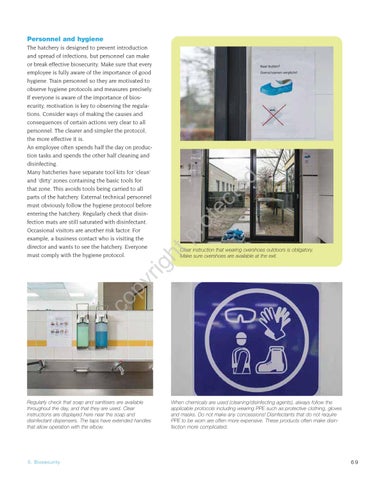te ec pr ot Clear instruction that wearing overshoes outdoors is obligatory. Make sure overshoes are available at the exit.
co
py
rig
ht
The hatchery is designed to prevent introduction and spread of infections, but personnel can make or break effective biosecurity. Make sure that every employee is fully aware of the importance of good hygiene. Train personnel so they are motivated to observe hygiene protocols and measures precisely. If everyone is aware of the importance of biosecurity, motivation is key to observing the regulations. Consider ways of making the causes and consequences of certain actions very clear to all personnel. The clearer and simpler the protocol, the more effective it is. An employee often spends half the day on production tasks and spends the other half cleaning and disinfecting. Many hatcheries have separate tool kits for ‘clean’ and ‘dirty’ zones containing the basic tools for that zone. This avoids tools being carried to all parts of the hatchery. External technical personnel must obviously follow the hygiene protocol before entering the hatchery. Regularly check that disinfection mats are still saturated with disinfectant. Occasional visitors are another risk factor. For example, a business contact who is visiting the director and wants to see the hatchery. Everyone must comply with the hygiene protocol.
d
Personnel and hygiene
Regularly check that soap and sanitisers are available throughout the day, and that they are used. Clear instructions are displayed here near the soap and disinfectant dispensers. The taps have extended handles that allow operation with the elbow.
5. B io s e c u r i t y
When chemicals are used (cleaning/disinfecting agents), always follow the applicable protocols including wearing PPE such as protective clothing, gloves and masks. Do not make any concessions! Disinfectants that do not require PPE to be worn are often more expensive. These products often make disinfection more complicated.
69








































































































